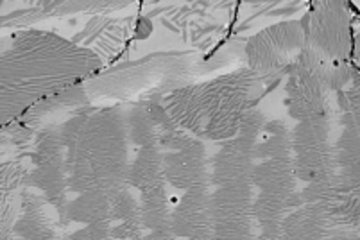All genres
81.
Journal Article
Advancing strength and counteracting embrittlement by displacive transformation in heterogeneous high-entropy alloys containing sigma phase. Acta Materialia 246, 118717 (2023)
82.
Journal Article
Materials for extreme environments. Nature Reviews Materials 8 (2), pp. 81 - 88 (2023)
83.
Journal Article
Understanding the protective ability of the native oxide on an Fe-13 at% Cr alloy at the atomic scale: A combined atom probe and electron microscopy study. Corrosion Science 211, 110848 (2023)
84.
Journal Article
The martensitic transition pathway in steel. Journal of Materials Science & Technology 134, pp. 244 - 253 (2023)
85.
Journal Article
Ductile 2-GPa steels with hierarchical substructure. Science 379 (6628), pp. 168 - 173 (2023)
86.
Journal Article
Finite strain crystal plasticity-phase field modeling of twin, dislocation, and grain boundary interaction in hexagonal materials. Acta Materialia 242, 118444 (2023)
87.
Journal Article
The Materials Science behind Sustainable Metals and Alloys. Chemical Reviews 123 (5), pp. 2436 - 2608 (2023)
88.
Journal Article
Fundamentals of Green Steel Production: On the Role of Gas Pressure During Hydrogen Reduction of Iron Ores. JOM-Journal of the Minerals Metals & Materials Society 75, pp. 2274 - 2286 (2023)
89.
Journal Article
Effect of Pore Formation on Redox-Driven Phase Transformation. Physical Review Letters 130, 168001 (2023)
90.
Journal Article
Impact of interstitial elements on the stacking fault energy of an equiatomic CoCrNi medium entropy alloy: theory and experiments. Science and Technology of Advanced Materials 23 (1), pp. 376 - 392 (2022)
91.
Journal Article
Hydrogen-assisted decohesion associated with nanosized grain boundary κ-carbides in a high-Mn lightweight steel. Acta Materialia 241, 118392 (2022)
92.
Journal Article
Machine-learning-based surrogate modeling of microstructure evolution using phase-field. Computational Materials Science 214, 111750 (2022)
93.
Journal Article
Phase transformations and microstructure evolution during combustion of iron powder. Acta Materialia 239, 118261 (2022)
94.
Journal Article
Machine learning–enabled high-entropy alloy discovery. Science 378 (6615), pp. 78 - 85 (2022)
95.
Journal Article
Stacking faults in a mechanically strong Al(Mg)–Al3Mg2 composite. Composites Part B: Engineering 245, 110211 (2022)
96.
Journal Article
Crystal plasticity simulation of in-grain microstructural evolution during large deformation of IF-steel. Acta Materialia 237, 118167 (2022)
97.
Journal Article
Deep learning framework for uncovering compositional and environmental contributions to pitting resistance in passivating alloys. npj Materials Degradation 6 (1), 71 (2022)
98.
Journal Article
Hydrogen/Deuterium Charging Methods for the Investigation of Site-Specific Microstructural Features by Atom Probe Tomography. Microscopy and Microanalysis 28 (S1), p. 1664 (2022)
99.
Journal Article
Hydrogen Trapping and Embrittlement in High-Strength Al Alloys. Microscopy and Microanalysis 28 (S1), p. 1660 (2022)
100.
Journal Article
Thermodynamics-guided alloy and process design for additive manufacturing. Nature Communications 13, 4361 (2022)











